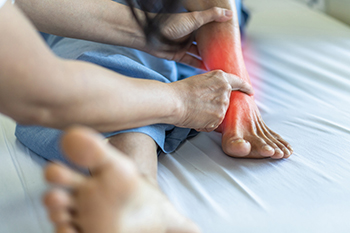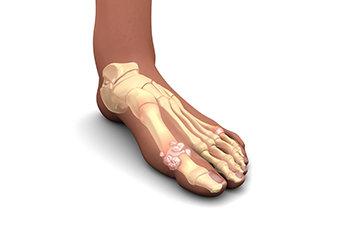
If you are a runner and are experiencing some pain in one of your toes, look for the following signs that may indicate you have a broken toe. First, is the pain you are feeling intense and throbbing? Do you notice any deformity, lumps or bumps on the toe? Is it difficult to walk or run? If you answered yes to any of these questions, you may have a broken toe. Swelling and severe bruising may also be present with a broken toe, and the toenail may also be discolored. A podiatrist can examine your foot and run imaging tests to make an accurate diagnosis. There are many ways a podiatrist can help your broken toe to heal, depending on which toe it is, where it is broken, and how badly it is broken. You will, no doubt, be anxious to get back to training, but running on a broken toe is not suggested. Listen to your body and your podiatrist, who will advise you on when it is safe to begin running again. Ask if there are other exercises you can do in the meantime to stay active.
Sports related foot and ankle injuries require proper treatment before players can go back to their regular routines. For more information, contact one of our podiatrists of Jill Einhorn, DPM and James Einhorn, DPM. Our doctors can provide the care you need to keep you pain-free and on your feet.
Sports Related Foot and Ankle Injuries
Foot and ankle injuries are a common occurrence when it comes to athletes of any sport. While many athletes dismiss the initial aches and pains, the truth is that ignoring potential foot and ankle injuries can lead to serious problems. As athletes continue to place pressure and strain the area further, a mild injury can turn into something as serious as a rupture and may lead to a permanent disability. There are many factors that contribute to sports related foot and ankle injuries, which include failure to warm up properly, not providing support or wearing bad footwear. Common injuries and conditions athletes face, including:
Sports related injuries are commonly treated using the RICE method. This includes rest, applying ice to the injured area, compression and elevating the ankle. More serious sprains and injuries may require surgery, which could include arthroscopic and reconstructive surgery. Rehabilitation and therapy may also be required in order to get any recovering athlete to become fully functional again. Any unusual aches and pains an athlete sustains must be evaluated by a licensed, reputable medical professional.
If you have any questions please feel free to contact our offices located in Brooklyn and Astoria, NY . We offer the newest diagnostic and treatment technologies for all your foot and ankle needs.

If you have ankle pain or they are stiff, stretching can help. Taking some time each day to work on the strength and flexibility of your ankles can help ease any discomfort you might experience and improve your range of motion. Start slowly and warm up with five to 10 minutes of low-impact exercise, such as walking, before doing such exercises. Simple movements that can help you care for your ankles include ankle circles to help with range of motion, stretching the Achilles and calves to prevent tightness, and yoga poses for ankle strength. You can use a towel and band to help with some of these stretches. If you feel pain while trying to care for your ankles or have injured your ankle or foot, it is important to check with a podiatrist before you undertake any activity that is new, including simple stretching and strengthening exercises. A podiatrist can instruct you on anything you might need to do to ensure proper healing and provide additional advice on how to care for your ankles.
Ankle pain can have many different causes and the pain may potentially be serious. If you have ankle pain, consult with one of our podiatrists from Jill Einhorn, DPM and James Einhorn, DPM. Our doctors will assess your condition and provide you with quality foot and ankle treatment.
Ankle pain is any condition that causes pain in the ankle. Due to the fact that the ankle consists of tendons, muscles, bones, and ligaments, ankle pain can come from a number of different conditions.
Causes
The most common causes of ankle pain include:
Symptoms
Symptoms of ankle injury vary based upon the condition. Pain may include general pain and discomfort, swelling, aching, redness, bruising, burning or stabbing sensations, and/or loss of sensation.
Diagnosis
Due to the wide variety of potential causes of ankle pain, podiatrists will utilize a number of different methods to properly diagnose ankle pain. This can include asking for personal and family medical histories and of any recent injuries. Further diagnosis may include sensation tests, a physical examination, and potentially x-rays or other imaging tests.
Treatment
Just as the range of causes varies widely, so do treatments. Some more common treatments are rest, ice packs, keeping pressure off the foot, orthotics and braces, medication for inflammation and pain, and surgery.
If you have any questions, please feel free to contact our offices located in Brooklyn and Astoria, NY . We offer the newest diagnostic and treatment technologies for all your foot care needs.

There are specific foot stretches which may help to loosen tight calf muscles, relieve arch cramps, and lessen heel pain. Little or no stretching may result in restricted mobility, and the risk of ripping, tearing, or straining a muscle may increase. Pointing and flexing the feet will successfully stretch the soles of the feet and strengthen the calves. It is important to note that while flexing the foot, it is beneficial to lead with the heel which can help to stretch the calf muscles. Additionally, while pointing the feet, it is more effective when the top of the arch is lengthened and pulled away from the body. When the feet are frequently stretched, chronic foot pain problems may be diminished, and the risk of getting foot and ankle injuries may be reduced. If you would like to know more about how to correctly stretch the feet, please speak with a podiatrist.
Stretching the feet is a great way to prevent injuries. If you have any concerns with your feet consult with one of our podiatrists from Jill Einhorn, DPM and James Einhorn, DPM. Our doctors will assess your condition and provide you with quality foot and ankle treatment.
Stretching the Feet
Being the backbone of the body, the feet carry your entire weight and can easily become overexerted, causing cramps and pain. As with any body part, stretching your feet can serve many benefits. From increasing flexibility to even providing some pain relief, be sure to give your feet a stretch from time to time. This is especially important for athletes or anyone performing aerobic exercises, but anyone experiencing foot pain or is on their feet constantly should also engage in this practice.
Great ways to stretch your feet:
Individuals who tend to their feet by regular stretching every day should be able to minimize foot pain and prevent new problems from arising.
If you have any questions, please feel free to contact our offices located in Brooklyn and Astoria, NY . We offer the newest diagnostic and treatment technologies for all your foot care needs.

Gout is a foot condition that affects the joints in the big toe. It is an extremely painful ailment that develops from excess uric acid levels in the bloodstream. Many patients have such debilitating pain that the weight of a bed sheet is too heavy. Gout may occur due to genetic reasons as well as eating foods that have high amounts of purines. There may also be medical reasons why someone develops gout. These can include having high blood pressure, being overweight, or having chronic kidney disease or diabetes. It often starts attacking the big toe and can spread to other parts of the body, if not treated promptly. An effective prevention method to reduce gout attacks can be a lifestyle change. This includes refraining from eating foods consisting of red meats, shellfish, and drinks that are made with large amounts of sugar. Additionally, it can help to start a gentle exercise program that can strengthen the body. Gout attacks can be properly diagnosed during a flare-up and X-rays may be taken. If you have gout it is strongly advised that you are under the care of a podiatrist who can help you to manage the pain and discuss effective prevention and treatment methods.
Gout is a painful condition that can be treated. If you are seeking treatment, contact one of our podiatrists from Jill Einhorn, DPM and James Einhorn, DPM. Our doctors will treat your foot and ankle needs.
What Is Gout?
Gout is a form of arthritis that is characterized by sudden, severe attacks of pain, redness, and tenderness in the joints. The condition usually affects the joint at the base of the big toe. A gout attack can occur at any random time, such as the middle of the night while you are asleep.
Symptoms
Risk Factors
Prior to visiting your podiatrist to receive treatment for gout, there are a few things you should do beforehand. If you have gout you should write down your symptoms--including when they started and how often you experience them, important medical information you may have, and any questions you may have. Writing down these three things will help your podiatrist in assessing your specific situation so that he or she may provide the best route of treatment for you.
If you have any questions, please feel free to contact our offices located in Brooklyn and Astoria, NY . We offer the newest diagnostic and treatment technologies for all your foot care needs.